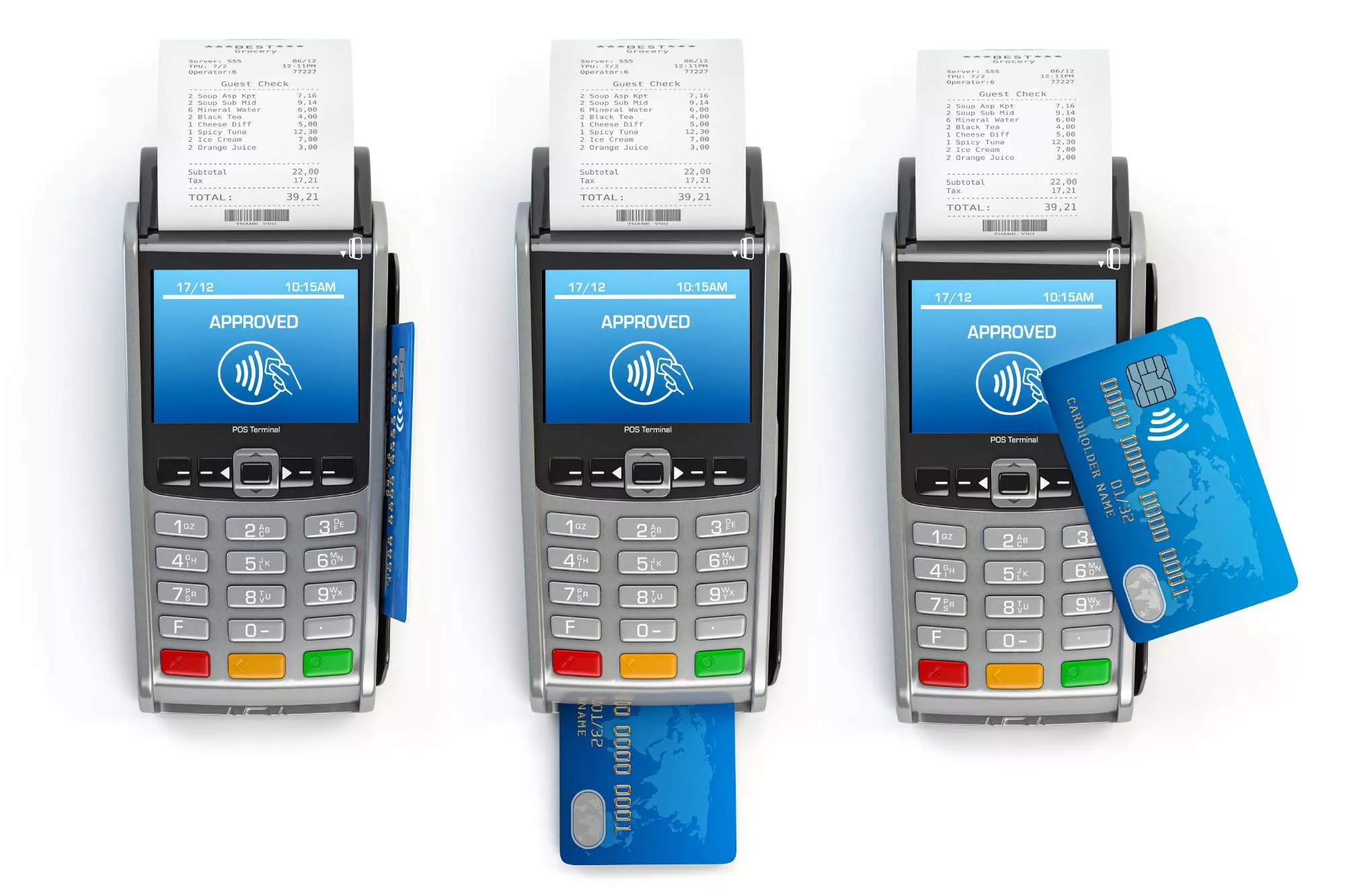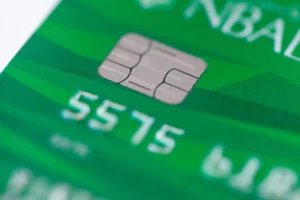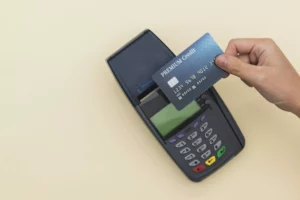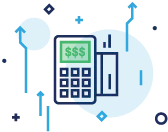
TABLE OF CONTENTS
- What is EMV?
- What Does EMV Stand For?
- How do Chipped Cards Work?
- Why are EMV Cards More Secure?
- What is EMV Compliance?
- Is Every Chip-Enabled Card EMV Compliant?
- How to Accept EMV Chip Cards at Your Business
- What Is EMV Liability Shift?
- What is an EMV Reader?
- How Much Do EMV Terminals Cost?
- Who Makes EMV Chips for Credit Cards?
- What are EMV Tags?
- EMV vs NFC: What’s the Difference?
- Can Your Business Use EMV for a Card-Not-Present Transaction?
- Final Thoughts
EMV cards have advanced payment processing and reduced fraud. While the credit card chip is not a silver bullet for combating fraud, it does provide more safety for credit card users and businesses.
What is EMV?

EMV represents the world standard for taking credit card transactions at physical point-of-sale (POS) locations and virtually. An EMV chip credit card greatly reduces fraud and speeds up in-store purchases.
What Does EMV Stand For?
“EMV” stands for the payment systems, Europay, Mastercard, and Visa. These three companies are responsible for putting the chip-and-pin or chip-enabled EMV card into use.
How do Chipped Cards Work?
The magnetic stripes on the older debit and credit cards carry all of a cardholder’s data. This information, which is not encrypted, makes it easy to make a counterfeit card. Therefore, thieves can easily steal the data via phone apps or strip readers.
The EMV chip creates a unique code each time a customer makes a purchase, thereby encoding a new entry each time.
Why are EMV Cards More Secure?
Card-present transactions that include EMV chip technology make it difficult for fraudsters to copy information. While chips for EMV cards encrypt and secure data, the older magstripe cards carry static data on their magnetized strips.
What is EMV Compliance?
Today, EMV represents the worldwide standard for debit and credit card processing. The technology is growing rapidly, especially in parts of Canada and Europe. EMV compliance means that a company uses point-of-sale (POS) processing equipment that features a credit card reader supporting EMV technology.
Is Every Chip-Enabled Card EMV Compliant?
A Visa, Mastercard, Discover, or AMEX-issued chip card is EMV compliant as it is designed for use with POS EMV-compliant technology.
How to Accept EMV Chip Cards at Your Business
To accept EMV chip cards at your business, you need to switch out your card reader and processor for a processor that reads activated chip-enabled credit and debit cards.
Is Your Business Required to Accept EMV Chip Cards?
Any business that processes credit or debit card purchases does not, legally, in the US, have to include an EMV card reader. While businesses are required to follow established EMV standards, it still is not mandatory for a business to comply.
EMV compliance legislation stipulates that businesses upgrade to POS systems to support EMV chips cards and compliance mandates. Otherwise, a business cannot avoid the repercussions of fraudulent activity, nor liability, under the new card chip reader statutes. In addition, you can get charged a fee if you have not enabled EMV processing for your business.
What Is EMV Liability Shift?
The EMV liability shift legally defines the transfer of responsibility for the losses of card issuers to businesses where an incorrectly manufactured chip card is used. Substantial financial losses supported this change, encouraging card issuers to alter their technology.
What is an EMV Reader?
An EMV reader reads the information on a chip-enabled card before it generates a unique code for order processing. Unlike a card with a magnetic stripe, the information on the chip is encrypted, making it difficult for fraudsters to copy the data.
How Much Do EMV Terminals Cost?
On average, an EMV terminal costs between $500 and $1,000. PaymentCloud can help connect your business with advanced EMV reader solutions. Find out about the best chip card terminals at the best prices.
Who Makes EMV Chips for Credit Cards?
EMVCo, a consortium that is made up of Discover, Mastercard, AMEX, JCB, Visa, and China Union Pay, sets the standard for EMV chip-manufacturing. Several companies make chips for the cards, including Gemalto (part of the Thales Group) and the CPI Card Group.
What are EMV Tags?
EMV tags represent a long alphanumeric string, based on a BER-TLV format, an Abstract Syntax Notation (ASN) type of encoding. This set of standards goes back to pre-Internet computerization. TLV stands for “Tag Length Value,” and BER-TLV is an expanded version of TLV.
Therefore, values used in EMV transactions are based on a card issuer’s implementation choices. These choices are identified and transported digitally by EMV tags. In the most basic terms, an EMV tag defines the information needed to process an EMV card transaction more securely.
EMV vs NFC: What’s the Difference?

When you review chip cards for payment processing, you will often associate the practices with (Europay, MasterCard, Visa) EMV and Near-Field Communications (NFC) technologies. NFC allows card data to be read by payment processing machines without contact.
While NFC often relates to phone payments (contactless processing), EMV is frequently associated with chipped cards. However, both technologies can be used in both payment situations. The NFC chip in a mobile phone can be used for contactless chip card processing. The encryption that safeguards payment details for EMV and NFC transactions is an EMV standard as well.
Today, you can use payment terminals that accept both NFC and EMV payments. Some machines take either NFC or EMV payments only. Most NFC/EMV readers will not take magnetic striped cards for payment processing.
Both EMV and NFC payments are encrypted and therefore more secure than magnetic strip cards. However, only EMV cards are subject to the fraud liability shift that was made legal in October 2015. This liability shift does not apply to the non-acceptance of NFC payments such as Apple Pay.
Can Your Business Use EMV for a Card-Not-Present Transaction?
You can use EMV cards for card-not-present (CNP) transactions. This may entail that a business manually key in the card details. Usually, EMV cards are used for card-present transactions or point-of-sale (POS) purchases. Payment apps for smartphones or tablets that don’t use a card reader can also facilitate EMV payments. An EMV card user can have their card with them but still make a CNP purchase.
Final Thoughts
To accept EMV chip cards you need to acquire an EMV chip card reader for payment processing. Doing so will make your business EMV compliant. Unlike a magstripe card, where the stripe is swiped in the processor horizontally, an EMV chip card is inserted vertically with its chip side up.





